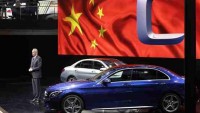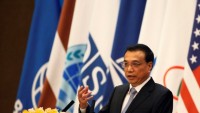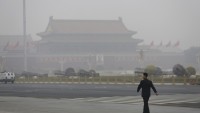China to Sink $40 Billion Into Silk Road That Connects it to Europe, MidEast And Central Asia
| Vittorio Hernandez | | Nov 09, 2014 02:39 AM EST |
(Photo : Reuters/Jorge Silva) Chinese President Xi Jinping wraps up his four-nation tour with bilateral agreements supporting his "One Belt and One Road" economic initiative.
While the FBI has shuttered the website Silk Road 2.0, another Silk Road is rising, yet though both Silk Roads are involved in the sale of goods, the new one surely won't be closed by the FBI or any other government body.
In fact, this brick-and-mortar Silk Road would span three continents - Asia, the Middle East and Europe. On Thursday, Chinese President Xi Jinping announced that China will allocate $40 billion to revive this historic trade route taken by Chinese merchants centuries ago, to sell the expensive textile and other commodities overseas, mainly the Mediterranean.
Like Us on Facebook
Xi told leaders from Bangladesh, Cambodia, Laos, Mongolia, Myanmar, Pakistan and Tajikistan that the infrastructure project is aiming to break Asia's connectivity bottleneck, as he declared that many countries in the continent are prepared "to get on board the train of China's development."
"Such a framework accommodates the needs of various countries and covers both land and sea-related projects," Reuters quoted the Chinese president.
Under the New Silk Road Economic Belt that Xi proposed in September 2013, the land-based component of the ambitious project, would begin at Shaanxi province's capital city, Xi'an, then move southwest across Central Asia, the MidEast and Europe. Meanwhile, the ocean-going part of the project starts near Guangdong Province on the South China Sea and traverses the Malacca Strait and Indian Ocean, moving further to the Horn of Africa into the Red Sea and Mediterranean.
The two routes will both lead to Venice, the port of entry for European trade with Asia during the period of famous traveler Marco Polo.
Besides constructing physical roads and setting maritime routes, the endeavor would also build 20,000 Silk Road centers that would train connectivity professionals in the next five years, Xi said.
Silk Road represents a new direction for China, unlike before where its focus was to attract foreign investments. But with the Asian giant becoming a global economic powerhouse, the once closed communist state is encouraging more of its capital to be spent overseas, observed Feng Yujun, senior researcher at the Beijing-based China Institutes of Contemporary International Relations.
Outside Silk Road, China's joining hands with 21 Asian countries in establishing the Asian Infrastructure Investment Bank (AIIB), which has an initial subscribed capital of 50-billion U.S. dollars, could pose a strong competition to the World Bank and the Asian Development Bank in global lending.
TagsSilk Road
©2015 Chinatopix All rights reserved. Do not reproduce without permission
EDITOR'S PICKS
-

Did the Trump administration just announce plans for a trade war with ‘hostile’ China and Russia?
-

US Senate passes Taiwan travel bill slammed by China
-

As Yan Sihong’s family grieves, here are other Chinese students who went missing abroad. Some have never been found
-

Beijing blasts Western critics who ‘smear China’ with the term sharp power
-

China Envoy Seeks to Defuse Tensions With U.S. as a Trade War Brews
-

Singapore's Deputy PM Provides Bitcoin Vote of Confidence Amid China's Blanket Bans
-

China warns investors over risks in overseas virtual currency trading
-

Chinese government most trustworthy: survey
-

Kashima Antlers On Course For Back-To-Back Titles
MOST POPULAR
LATEST NEWS
Zhou Yongkang: China's Former Security Chief Sentenced to Life in Prison

China's former Chief of the Ministry of Public Security, Zhou Yongkang, has been given a life sentence after he was found guilty of abusing his office, bribery and deliberately ... Full Article
TRENDING STORY

China Pork Prices Expected to Stabilize As The Supplies Recover

Elephone P9000 Smartphone is now on Sale on Amazon India

There's a Big Chance Cliffhangers Won't Still Be Resolved When Grey's Anatomy Season 13 Returns

Supreme Court Ruled on Samsung vs Apple Dispute for Patent Infringement

Microsoft Surface Pro 5 Rumors and Release Date: What is the Latest?














